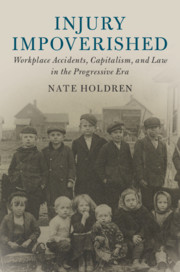Book contents
- Injury Impoverished
- Cambridge Historical Studies in American Law and Society
- Injury Impoverished
- Copyright page
- Epigraph
- Contents
- Tables
- Acknowledgments
- Introduction
- Part I The Eclipse of Recognition and the Rise of the Tyranny of the Table
- 1 Commodification and Recognition within the Tyranny of the Trial
- 2 Injury Impoverished
- 3 Suffering and the Price of Life and Limb
- Interlude
- Part II New Machineries of Injustice
- Conclusion
- Coda
- Index
2 - Injury Impoverished
from Part I - The Eclipse of Recognition and the Rise of the Tyranny of the Table
Published online by Cambridge University Press: 06 April 2020
- Injury Impoverished
- Cambridge Historical Studies in American Law and Society
- Injury Impoverished
- Copyright page
- Epigraph
- Contents
- Tables
- Acknowledgments
- Introduction
- Part I The Eclipse of Recognition and the Rise of the Tyranny of the Table
- 1 Commodification and Recognition within the Tyranny of the Trial
- 2 Injury Impoverished
- 3 Suffering and the Price of Life and Limb
- Interlude
- Part II New Machineries of Injustice
- Conclusion
- Coda
- Index
Summary
Chapter 2 focuses on social investigators and policy reformers who criticized the court-based system of employee injury law and called for compensation laws. The chapter argues that these investigators and reformers had genuine concerns with social justice and understood the personal and dignitary harms inflicted by employee injury. At the same time, they were most concerned with economic harms and their implicit theories of justice were largely centered on distributive concerns like inequality and poverty. As a result, advocates for social justice unwittingly ended up helping create a relatively one-sided picture of employee injury as a problem, a picture that ultimately neglected the non-distributive human costs of injury.
Keywords
- Type
- Chapter
- Information
- Injury ImpoverishedWorkplace Accidents, Capitalism, and Law in the Progressive Era, pp. 53 - 83Publisher: Cambridge University PressPrint publication year: 2020

